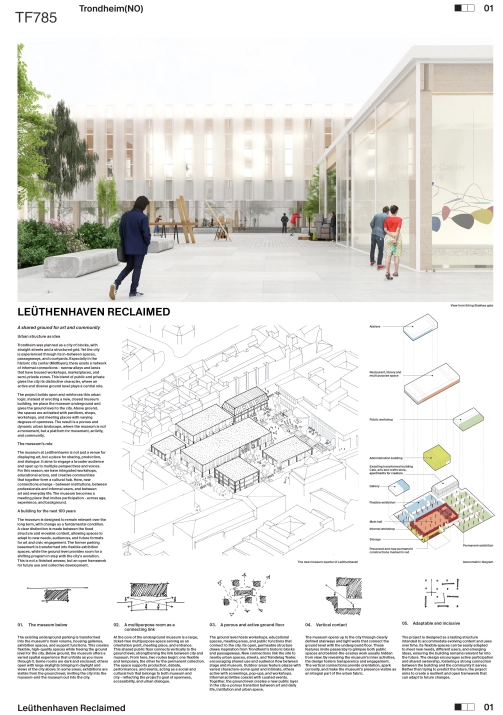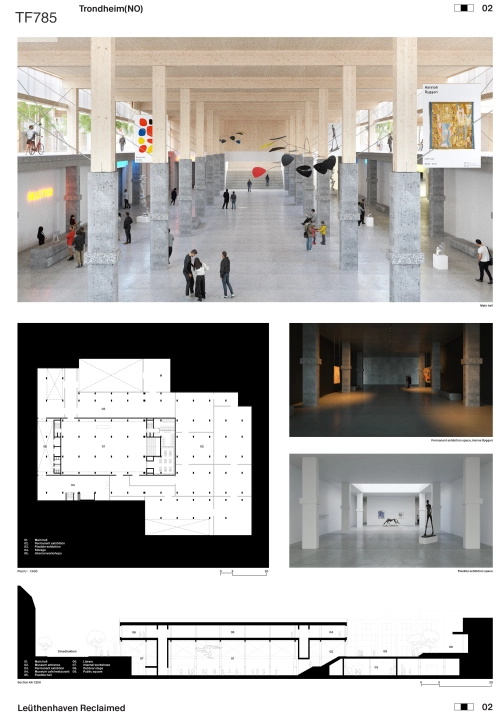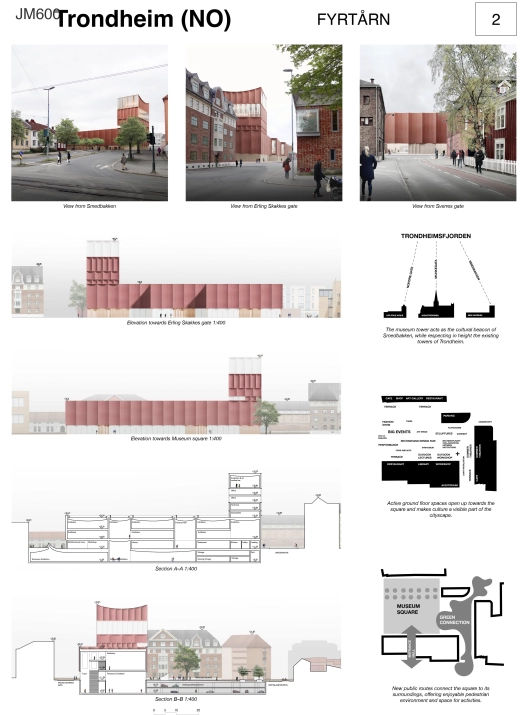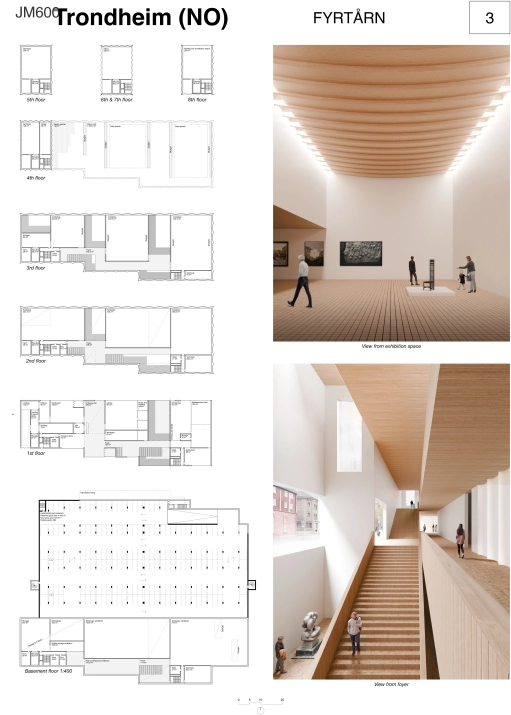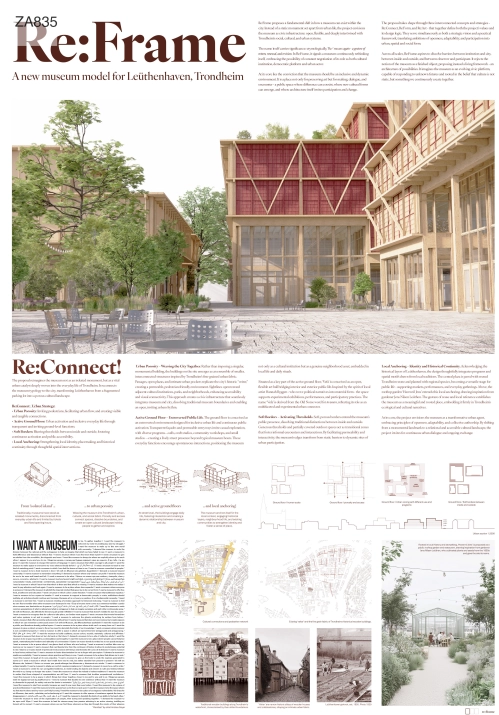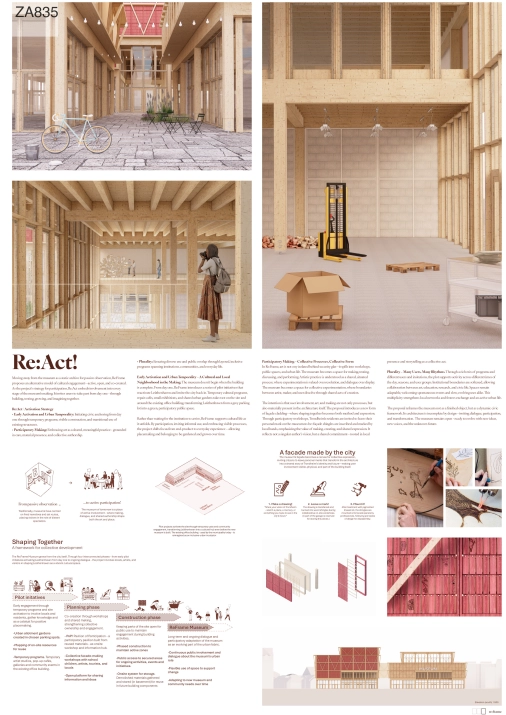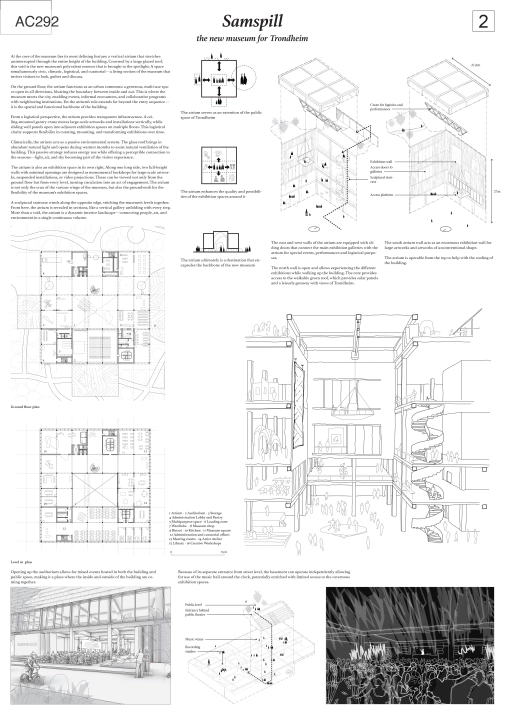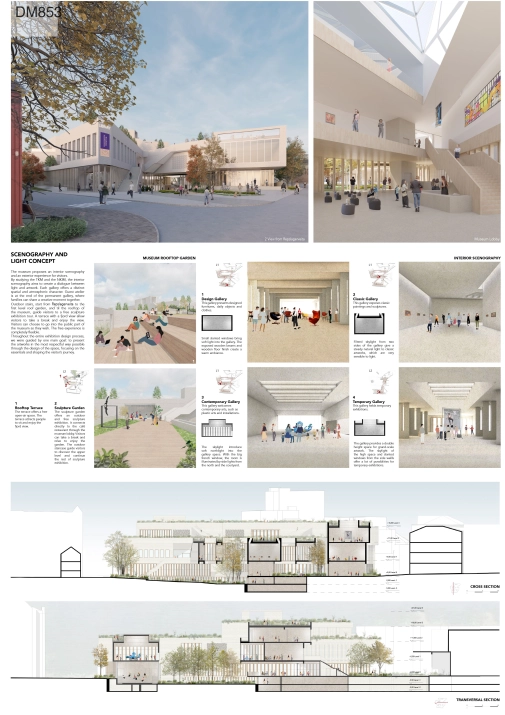Leüthenhaven Reclaimed won the competition in Trondheim!

The project Leüthenhaven Reclaimed by Haakon Walderhaug, Oskar Wilfred Johnsen Aronsen, Jeppe Bervell Johnsen and Mille Mee Herstad won the competition in Trondheim!
General Remarks by the jury
The Trondheim site attracted the largest number of participants of all the sites in this edition of Europan, with a total of 60 entries. This high level of interest can be attributed to the site’s classical architectural task, combined with an urban ambition that makes it both conceptually and practically engaging. The jury thinks that the opportunity to reuse the existing parking garage, the site’s proximity to other cultural institutions such as the regional theatre, and its clearly defined program within the consolidated urban fabric of Midtbyen all contributed to its strong appeal among participants.
A central aspect of the competition was to explore the site’s capacity to host a new city museum - balancing built volume and open public space, and considering its relationship with the theatre. Leutenhaven represents one of the last areas open for development in the consolidated city center and is therefore of great value to Trondheim’s inner urban structure. Within this context, the museum’s ambition extends beyond that of a traditional institution: it seeks to offer a new kind of public space for the city.
During the Europan Forum in Lisbon, it was questioned whether such a typical architectural assignment could truly be considered a Europan project. The answer, however, is affirmative - precisely because of the explorative character of the programme and the urban ambitions embedded in the brief. This is not merely a museum, but an exploration of new forms of publicness. The task offers an opportunity to rethink the museum typology, challenging preconceived ideas of what a contemporary museum can be when meeting the specific conditions of Trondheim, including the potential reuse of existing structures.
The jury observed a wide variety of approaches among the 60 submissions - both formally and programmatically, as well as in architectural expression and structural concept. The entries offered diverse interpretations of how the museum could act as a public space and a threshold between exhibition activity and urban life. They also varied in how they positioned the museum on the site and how they sought to integrate it into its context. Looking at the project overall, it's clear that generating altogether new typologies and approaches for a museum of the future is no easy task when you also have to consider the programmatic requirements of a museum of the “present”. The expectations of museum architecture are very complex: Publicness, complex programs and operations, security, urban aspirations, all coupled with an urge for unique architecture. Managing these expectations while also challenging the traditional identity of the museum to make it accessible to new user groups is a challenging task, both for the architects and the client.
The jury found that the most successful proposals were those that demonstrated a sensitive integration with the existing urban environment - carefully considering the building’s positioning, the reuse of the parking garage, the choice of materials, and the relationship between new and existing volumes. These projects succeed in creating meaningful connections with the surrounding streetscape and urban spaces, reinforcing the museum’s potential role as an active and engaging civic landmark in Trondheim’s city centre. The jury thinks the competition successfully demonstrates that Leuthenhaven is well-suited for this type of program, and the unique opportunities that lie in rethinking the museum's publicness.
The winning project manages to boldly deal with a range of themes and turn them into a holistic proposal that is both radical and human at the same time: demonstrating that one can indeed redefine what it means to be an iconic institution by using reuse, climate footprints, and low-threshold accessibility for new user groups as the project’s driving force.
Download the full report for feedback on projects
Team
Haakon Walderhaug (NO), architect
Oskar Wilfred Johnsen Aronsen (NO), architect
Jeppe Bervell Johnsen (NO), student in architecture
Mille Mee Herstad (NO), architect
Saulius Bulavas, architect
Adrian Rove Nordgård, architect
Jury remarks
The winning proposal stands out for its strong engagement with the existing structure and the city. The project’s central idea - a multipurpose public living room at the heart of the museum - establishes a generous and engaging indoor public space while reusing the existing parking structure. This strategy not only grounds the project in the realities of the site but also conveys a powerful message about urban transformation and sustainability: turning a parking garage into a museum redefines priorities, placing culture before cars in the city centre.
The main image of the underground space is particularly compelling and suggests an inviting atmosphere that encourages gathering and exploration. The proposal puts value on the parking garage and aims to reuse its space and constructive elements. The ambition to work with what already exists remains one of the project’s most distinctive and relevant qualities. This concept is not only an environmental approach, but it also gives the building its distinct character. The reuse of elements from the parking garage becomes part of the expression of the building, releasing its spatial and expressive potential. The jury notes that realizing such a space would most likely require an extensive reconstruction and reshuffling of structural elements to achieve the requirements of a contemporary art museum, but believes that this can be done while maintaining the character of the proposal.
At the plaza level, the museum expresses itself as a village-like ensemble that relates closely to the existing “veiter” (alleys) of Trondheim’s Midtby. The orientation of the smaller volumes toward the surrounding housing and the creation of intimate streets between them establish a meaningful dialogue with the neighbourhood fabric. The concept invites curiosity and exploration, offering a rich variety of engaging spaces for all groups, including children and youth. The inclusion of pocket parks and varied outdoor areas demonstrates sensitivity to the existing urban context and encourages public interaction at multiple scales. The entrance sequence is somewhat monumental; however, this impression is softened by the composition of the building volumes and the possibility for visitors to move around and look down into the central space. This spatial layering makes the museum more open and approachable, transforming monumentality into a sense of civic generosity.
The jury appreciates the project’s urban strategy but notes that the spaces between the buildings could be developed to be more active and programmatically rich. At present, the street level at some points appears relatively passive, which may limit the museum’s extroversion and everyday liveliness. Further activation/ programming of the street level could help strengthen the public interface and enhance the overall urban experience.
The main exhibition areas are located on the basement level, surrounding the central multipurpose room. In addition, smaller satellite exhibition spaces positioned on the plaza level offer direct exposure to the city, strengthening the museum’s dialogue with the public realm. At certain points, the exhibition volumes emerge from the ground, creating a dynamic variation of heights, light conditions, and visual connections to urban life above. The exhibition design strikes a balance between spatial specificity and adaptability, allowing the museum to house a wide range of programs and experiences over time.
Leuthenhaven Reclaimed is a bold yet understated project that demonstrates that one can rethink the museum’s relationship with the public, creating not just a flexible and human concept for a new type of museum, but also a good public space and the start of what can be a rich cultural exchange with the theater that can revitalize Midtbyen.
Team
Heljä Nieminen (FI), architect
Havu Järvelä (FI), architect
Jury remarks
This proposal stands out as a “lighthouse” — a project that is highly visible and immediately recognizable. It establishes a strong and confident architectural character, demonstrating a clear design will and a belief in creating identity through form and presence. The project convincingly looks and feels like a museum.
The provocative and bold expression positions it as a potential landmark, while its realistic organizational layout gives it credibility. The design creates impressive indoor spaces that appear functional and engaging. The decision to retain some parking in the underground levels might also make the project more acceptable to local politicians and residents, easing its integration into the city’s existing infrastructure.
The building challenges the existing height structure of Midtbyen by making part of the building at the height of the main body of Nidarosdomen. This bold move provides visibility from afar- A “lighthouse” effect at the same time as it invites visitors to the museum to enjoy the view. In the jury, there are doubts about challenging the building heights of Midtbyen, also the already built museum Rockheim has a similar approach.
The proposal allows the northern part of the site to breathe, and the resulting open space maintains existing pedestrian shortcuts through the area — a generous gesture to the city’s fabric. However, the orientation of the main volume raises concerns. The way shadows will fall on the public space is problematic. If the building were rotated 90 degrees - placing the higher volume toward the south and the lower part toward the smaller neighboring buildings - it would fit the site more harmoniously and improve sunlight conditions.
While the project creates a generous public space, the urban composition feels unresolved. The indoor circulation is oriented toward the street rather than the plaza, which reduces the connection between interior and exterior public life.
Public extrovert functions of the museum are correctly placed on the ground floor, but there are concerns about their level of engagement with the surrounding city life. The museum appears somewhat formal and monumental, which may limit its accessibility and appeal to non-traditional museum users. A stronger emphasis on creating a low-threshold, inclusive atmosphere would strengthen the project.
Team
Hedvig Skjerdingstad (NO), architect
Jury remarks
Re:Frame has an extroverted character, and the buildings are engaging with the cityscape. Re:Frame is referencing the traditional alleyways of Trondheim (veiter), which are transformed into a new and exciting form. The project is successful in creating a new, balanced public space and new thoroughfares connecting the museum to the city.
The fragmentation of the volumes creates a defined public space towards the north street, and its small-scale wooden buildings. The fragmentation of the volumes also poses challenges, and some potential weaknesses will be the amount of buildings with many entrances, without a clear main entrance.
The system of the museum is explained well, and the graphics are concise. The illustrations would have benefited from including the Re:Frame’s proposal in relation to the existing situation, and including people and some public programming in the illustrations.
Re:Frame could benefit from a further detailing of the “veite” spaces and a less generic visual appearance. But overall, the buildings are engaging in a dynamic way, inviting people to participate in a new museum, with a good relation to the city’s streetscape and public space, and a visual character connected to Trondheim.
Team
Gaetano Giordano (IT), architect
Dimitrios Andrinopoulos (GR), architect
Jury remarks
The Samspill project presents a compact and well-considered concept for the museum in Trondheim. It proposes a concentrated building volume, with the museum program wrapped around a central public atrium. This atrium serves as the aesthetic, logistical, and functional spine of the building, connecting spaces and functions. The porous podium ensures accessibility from multiple directions, allowing the ground floor to integrate naturally with the surrounding public space.
The proposal remains faithful to the original idea and concept, showing thorough refinement throughout the design process. It is both generic and specific—an adaptable framework that accommodates a wide range of possibilities for the museum’s future development. The project demonstrates strong spatial variation and richness. The placement on the site could have been more sensitive, and the landscape and outdoor areas appear underdeveloped.
The prsentation does not fully support the strength of the proposal. Samspill would benefit from a clearer and more communicative visual narrative. The lack of an overall 3D-illustration showing the building in its context limits the understanding of the project. Overall, the project proposes a clear and compelling vision of an inviting museum that has the potential to function really well.
Team
CHENGXIN LI (CN), architect
Zhaoying Zhu (CN), architect urbanist
Jian GUAN (CN), architect urbanist
Jury remarks
Veve is creating something new without copying history. The placement and fragmentation of volumes create an engaging new public museum and a new public space which has not yet been seen in Trondheim.
Whilst the fragmented volumes are successful in creating interest and excitement towards the city and public space, it is not flexible in terms of organization, and will create a challenge to the museum’s internal organization. There is no clear centrality, and wayfinding may be difficult.
Veve is professional in its approach and representation. The proposal could work in many places and with programs other than a museum. The proposal could benefit from a visual appearance that is more connected to the place and city of Trondheim, as it does have a generic streak.
Veve is successful in terms of public space: it is one of the few projects that tries to create a real urban plan with the green axis; it contains short-cuts through the plot, and the shape and expression of the museum creates a variety of dynamics from different angles, which creates a richness in building volumes and experience for visitors and passers-by alike.
